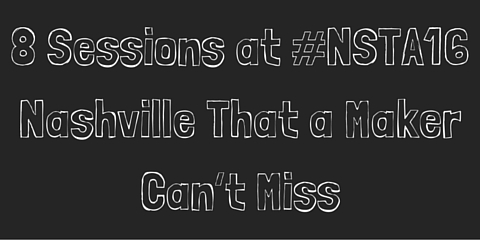8 Sessions at #NSTA16 Nashville That a Maker Can’t Miss
By Korei Martin
Posted on 2016-03-10
The maker movement will be strong at #NSTA16 this spring. At NSTA’s National Conference on Science Education, taking place in Nashville, March 31–April 3, DIY science teachers will be showing off their best strategies for getting students into building and learning from models, robots, and more. Get ready to roll up your sleeves and dig in (no sitting around in these action-packed sessions). You’ll be building inexpensive structures to better understand DNA structure and replication and get to tinker with motors to learn to help your students better understand the fundamental concepts of magnetic and electromagnetic fields. No matter if you’re just starting out in the Maker movement or you’re a seasoned pro, you’ll find the resources and tools that you need. Check out the seven sessions below to get a sense of what we’ve got in store, and browse all the sessions here (more than 1000 of them!) to see who’s showing you how to turn your education space into an interactive Maker Space.
Featured Speaker Presentation: The Tinker.Make.Innovate. Program
- Join Jean Kaneko for the Thinker.Make.Innovate. Program featured session during NSTA Nashville. The Tinker.Make.Innovate. Program brings together design thinking, systems thinking, making, and standards to create Project-Based Learning opportunities for students—preschool to high school. Join the Exploratory’s founder and “Chief Tinkerer” as she shares case stories from the Los Angeles schools’ THE STEAM program, as well as Genius Hour/20% Time programs, which provide connected learning that is challenging, engaging, and inspiring.
Build, Program, and Control with K’NEX Education’s New Robotics Building System
- This dynamic hands-on building system teaches students how to apply programming skills to operate various built models. You’ll be the student in this workshop, as you write your own computer program to control a vehicle model built out of K’NEX! Space limited: 24 working, 20 observing. Arrive early!
Use Robots to Engage Elementary/Middle School Students with Hands-On Project Based Learning
- Working in small groups, you’ll learn how to guide students in building and programming a LEGO® EV3 robot, research and solve a real-world problem, develop core values, and practice collaboration and presentation skills. Explore the FIRST® LEGO® League Program and learn how to bridge classroom learning into after-school enrichment.
Building an Electric Motor the STEM Way with CPO’s Link™ Learning Module
- CPO’s new Link Electric Motor learning module is a STEM- and NGSS-based learning approach to electromagnets, permanent magnets, commutators, and induction in a real-time tablet-based learning environment using hands-on equipment. The engineering cycle, observation, measurement, and experimentation are used to design and build electric motors with student-based activities.
Challenge Your Students to Make Motors
- Attract your students’ interest by exploring fundamental concepts of magnetic and electromagnetic fields. Students will build eight different classroom motors. Take home teaching unit with step-by-step instructions, explanations of each motor’s operation, and hands-on experience building them.
Apply the Science of Energy, Motion, and Friction
- Students will design and build cutting-edge vehicles to investigate stored energy from sources such as a rubber bands or mousetraps. The kit components—wood chassis, mousetraps, braking systems, and several types of wheels and gears—allow students to develop a greater number of solutions and apply real-world problem solving skills to create innovative designs.
Lift Weight and Produce Electricity with the Power of Wind
- With this STEM-based project kit, students are able to build a wind-powered lift or a more advanced turbine. Students will design their own blades to generate and measure power while investigating blade configuration, shape, and material to create ideal power levels. Our kit meets the NGSS and includes components for up to eight students—wood bases, motors/motor supports, hubs/alligator clips, blade shafts/skewers, and wooden support structures.
Using Models and Motion for Teaching DNA and Protein Synthesis
- Engage in kinesthetic activities and build inexpensive models to help students learn DNA structure, DNA replication, and protein synthesis while using a 5E (Engage, Explore, Explain, Elaborate, and Evaluate) approach.
Register to attend here—and don’t forget, NSTA members get a substantial discount!
The mission of NSTA is to promote excellence and innovation in science teaching and learning for all.
Future NSTA Conferences
2016 National Conference
2016 STEM Forum & Expo
2016 Area Conferences
Follow NSTA
Disclaimer: The views expressed in this blog post are those of the author(s) and do not necessarily reflect the official position of the National Science Teaching Association (NSTA).



